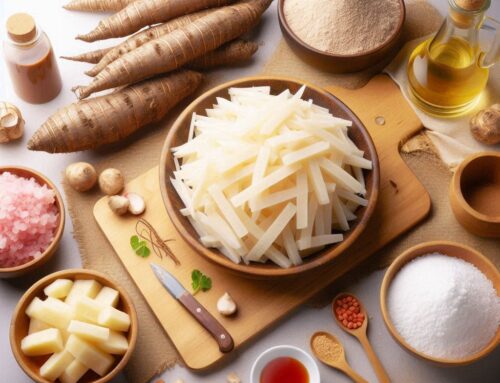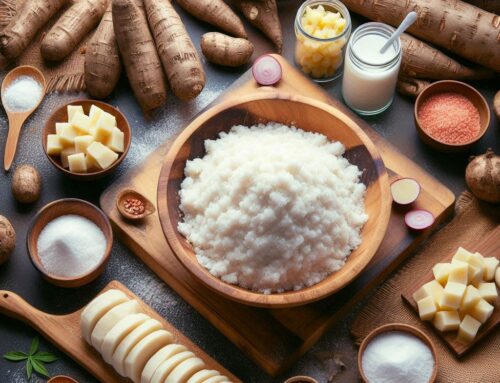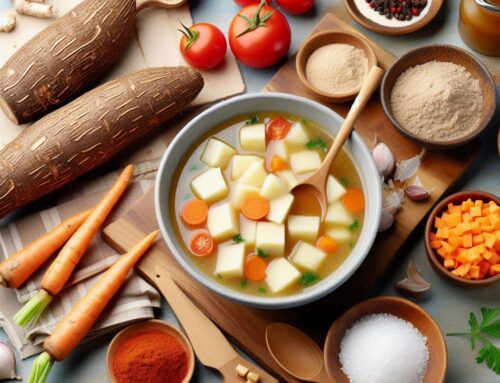
Introduction: Understanding Cassava and Its Benefits
Cassava, a staple root crop in many tropical regions, is an essential component of the global food supply. Known scientifically as Manihot esculenta, the cassava plant is celebrated for its adaptability and resilience in diverse climates. This hardy plant thrives in poor soils and can withstand periods of drought, making it a reliable food source in areas prone to challenging agricultural conditions.
The benefits of cassava are manifold. Nutritionally, it serves as an excellent source of carbohydrates, providing substantial energy for millions worldwide. Beyond its caloric content, cassava also contains essential vitamins and minerals such as vitamin C, thiamine, riboflavin, and niacin. In addition to its dietary value, cassava plays a significant role in various industries due to its versatility.
Cassava cultivation is relatively straightforward; it requires minimal inputs compared to other crops like maize or rice. This ease of cultivation makes it particularly attractive for smallholder farmers looking to secure their livelihoods with limited resources. Furthermore, cassava uses extend beyond human consumption; the plant’s starch is utilized in numerous industrial applications ranging from textiles to biofuels.
Understanding why grow cassava involves recognizing its dual role as both a food security crop and an economic commodity. Its ability to support sustainable agriculture while contributing to local economies underscores the importance of promoting cassava cultivation across suitable regions globally. As we continue exploring innovative ways to harness this remarkable plant’s potential, it’s clear that cassava will remain integral not only as a dietary staple but also as a catalyst for development and growth within agricultural communities worldwide.
Selecting the Right Variety of Cassava for Your Garden
When it comes to selecting the right variety of cassava for your garden, understanding the types of cassava available is crucial. Cassava, a versatile and hardy plant, is primarily categorized into two main types: sweet and bitter. Both have their unique characteristics and uses, but choosing the best cassava variety for home gardens largely depends on your specific needs and growing conditions.
Sweet cassava varieties are generally preferred for home gardens due to their lower cyanide content, making them safer and easier to prepare. These types are ideal if you plan to consume the roots without extensive processing. Varieties like ‘Brazilian’ or ‘Golden Yellow’ are popular among gardeners looking for a sweeter taste.
On the other hand, bitter cassava requires more processing but can offer higher yields and greater pest resistance. This type might be suitable if you’re interested in producing flour or starch on a larger scale.
When choosing cassava plants for your garden, consider factors such as climate adaptability, soil conditions, and intended use of the harvest. Research local varieties that thrive in your region’s climate; this ensures healthy growth and optimal yields.
By carefully evaluating these aspects, you can select a cassava variety that not only thrives in your garden but also meets your culinary or production needs effectively.
Preparing Your Backyard for Planting Cassava
Preparing your backyard for planting cassava involves several key steps to ensure a healthy and productive crop. One of the first considerations is selecting the right planting site. Cassava thrives in well-drained soil with plenty of sunlight, so choose a location in your backyard that receives ample sun exposure and has good drainage. Avoid areas prone to waterlogging, as this can hinder root development.
Once you’ve chosen the ideal spot, focus on soil preparation for cassava. This root vegetable prefers loose, sandy loam soils rich in organic matter. Begin by clearing the area of weeds and debris, then till the soil to a depth of about 12 inches to improve aeration and drainage. Incorporating organic compost or well-rotted manure can enhance soil fertility, providing essential nutrients that cassava needs for optimal growth.
Backyard gardening tips also suggest testing your soil’s pH level; cassava grows best in slightly acidic to neutral soils with a pH range between 5.5 and 7. If necessary, adjust the pH by adding lime to raise it or sulfur to lower it according to test results.
By carefully considering these factors—site selection, proper soil preparation, and meeting cassava’s specific requirements—you’ll set a solid foundation for cultivating this versatile crop successfully in your backyard garden.
A Step-by-Step Guide to Planting Cassava in Your Backyard
Planting cassava in your backyard can be a rewarding endeavor, offering a reliable source of nutritious tubers. For beginners, it’s essential to follow proper planting techniques to ensure healthy growth and bountiful yields. Here’s a step-by-step guide to get you started.
First, select healthy cassava stems for planting. Choose stems that are about 2-3 centimeters in diameter and 20-30 centimeters long. These should be disease-free and have visible nodes where new growth will emerge.
Next, prepare your soil by ensuring it is well-drained and rich in organic matter. Cassava thrives in loamy soil with good aeration. If necessary, amend your soil with compost to improve its fertility.
When it comes to spacing and depth guidelines, plant the cassava stems at an angle of 45 degrees into the ground, burying them about two-thirds of their length. This helps promote robust root development. Maintain a spacing of approximately one meter between each stem to allow ample room for growth.
Watering is crucial during the early stages of cassava development. Ensure that the plants receive consistent moisture without becoming waterlogged. Water deeply once or twice a week, depending on rainfall and climate conditions in your area.
By following these steps on how to plant cassava stems effectively, even beginners can look forward to harvesting their own homegrown cassava tubers with ease.
Caring for Your Growing Cassavas: Maintenance and Troubleshooting Tips
Caring for your cassavas requires a thoughtful approach to ensure healthy growth and a bountiful harvest. This cassava care guide provides essential tips on maintenance and troubleshooting to help you along the way.
First, understanding the fertilization needs of cassavas is crucial. These plants thrive in nutrient-rich soil, so regular fertilization is key. Use a balanced fertilizer that includes nitrogen, phosphorus, and potassium to promote robust root development. Applying compost or well-rotted manure can also enhance soil fertility and improve plant health.
Pest control is another important aspect of cassava maintenance. Common pests include mites, mealybugs, and aphids, which can damage leaves and stunt growth. To manage these pests effectively, consider using organic insecticides or introducing beneficial insects like ladybugs to your garden as natural predators.
Lastly, be aware of common problems with growing cassava such as root rot or leaf blight. Ensure proper drainage in your planting area to prevent waterlogged conditions that lead to root rot. For leaf blight issues, maintain good air circulation around the plants by spacing them adequately and removing any infected foliage promptly.
By following these care guidelines and troubleshooting tips, you can support your growing cassavas through each stage of their development while minimizing potential challenges along the way.
Harvesting and Utilizing Your Homegrown Cassavas Effectively
Cassava is a versatile and nutritious root vegetable that can be a rewarding addition to any home garden. Knowing when to harvest cassava is crucial for maximizing its yield and flavor. Typically, cassava plants are ready for harvest between 8 to 12 months after planting, depending on the variety and growing conditions. The key indicator is the yellowing of the lower leaves, which suggests that the roots have matured.
When it comes to harvesting techniques, it’s important to handle the roots with care to prevent damage. Begin by loosening the soil around the base of the plant with a spade or fork. Gently pull up the plant while ensuring you extract as many roots as possible without breaking them.
Once harvested, proper storage of cassava roots is essential since they can spoil quickly if not handled correctly. Ideally, store them in a cool, dry place or consider processing them into flour or chips for longer shelf life.
Cooking with cassava opens up a world of culinary possibilities—from boiling and frying to baking. Before cooking, always peel and thoroughly wash the roots to remove any toxins naturally present in raw cassava. Whether you’re making traditional dishes like cassava fries or experimenting with new recipes like gluten-free bread, this root vegetable offers both versatility and nutrition in your kitchen endeavors.






